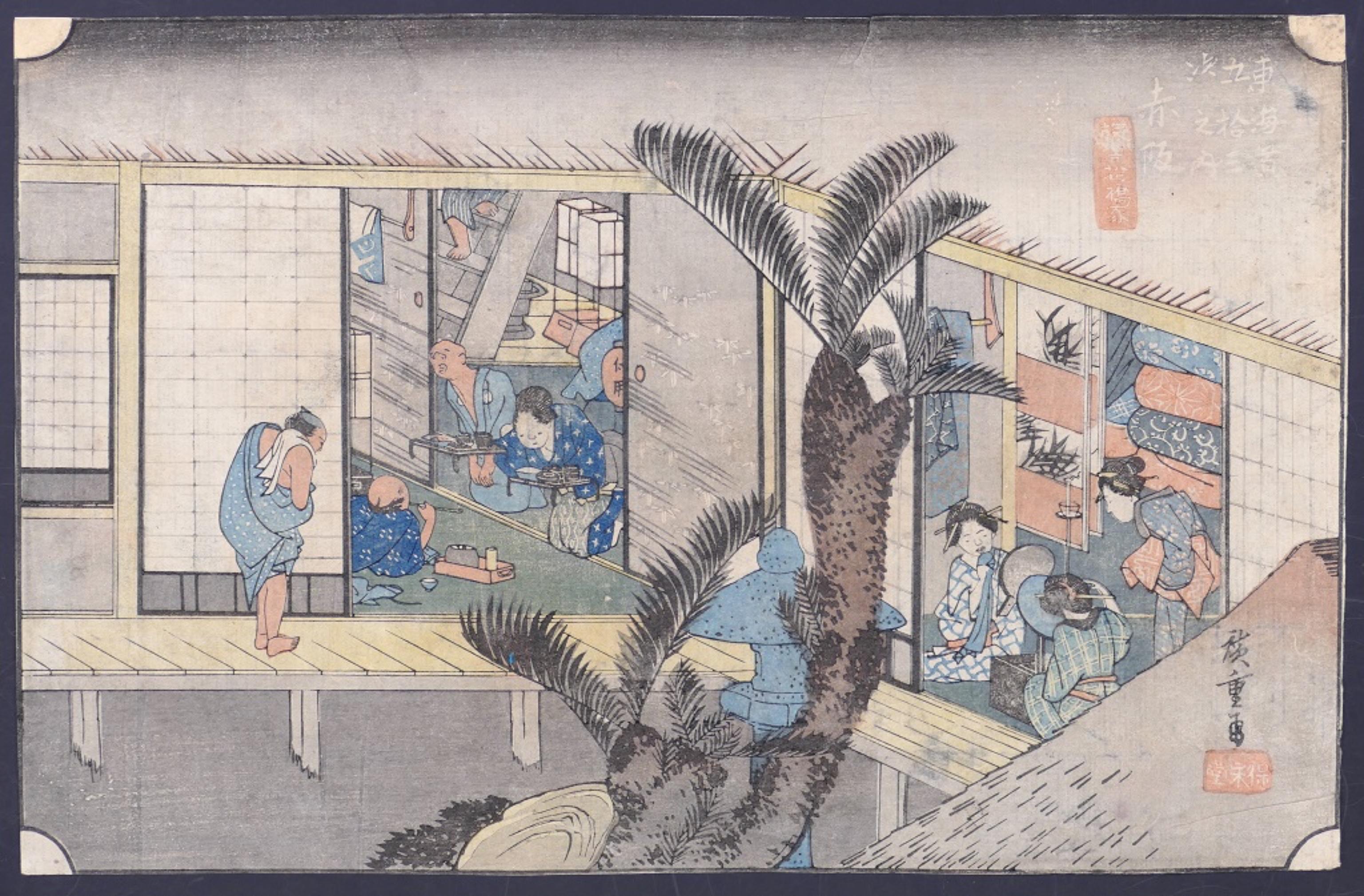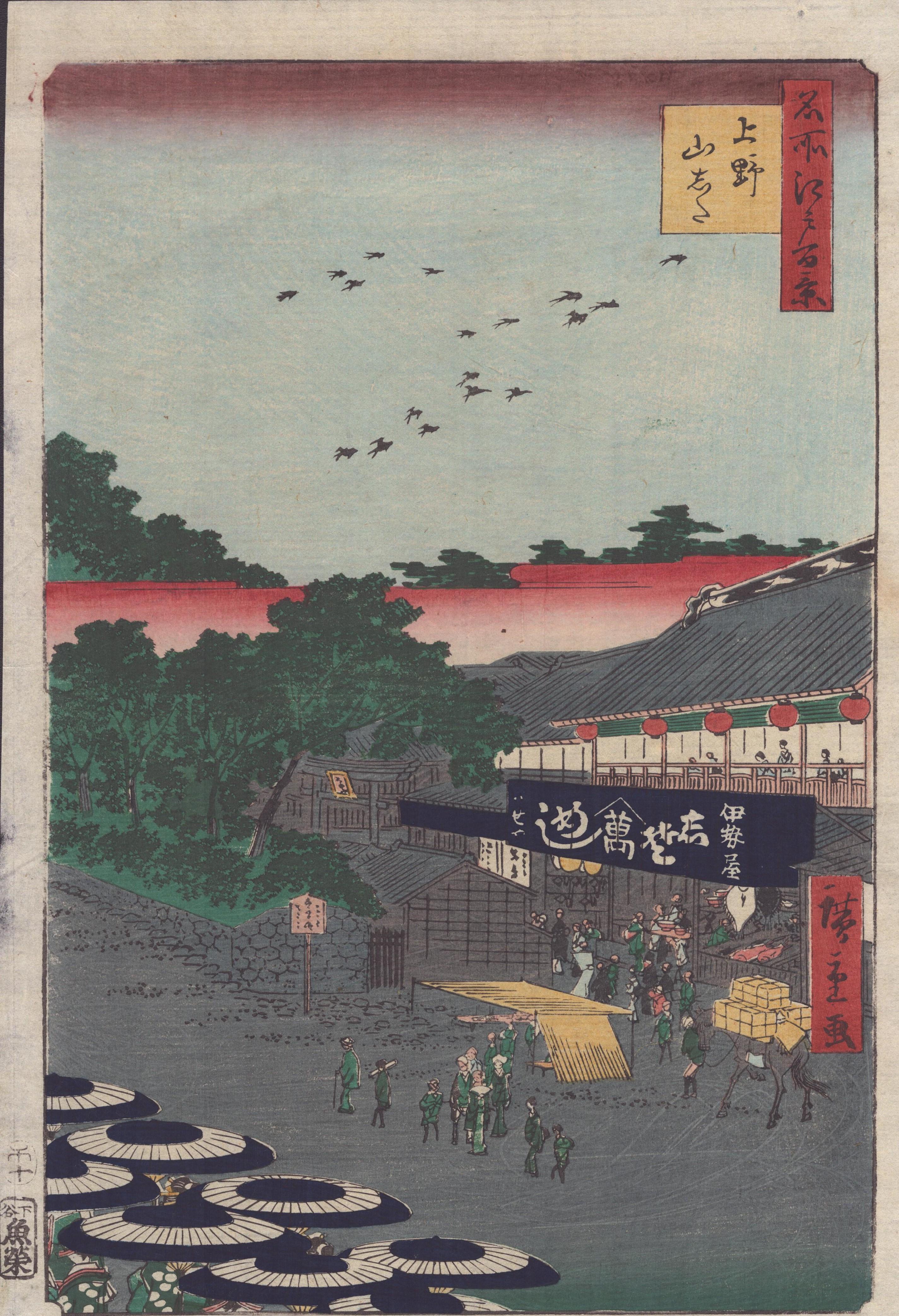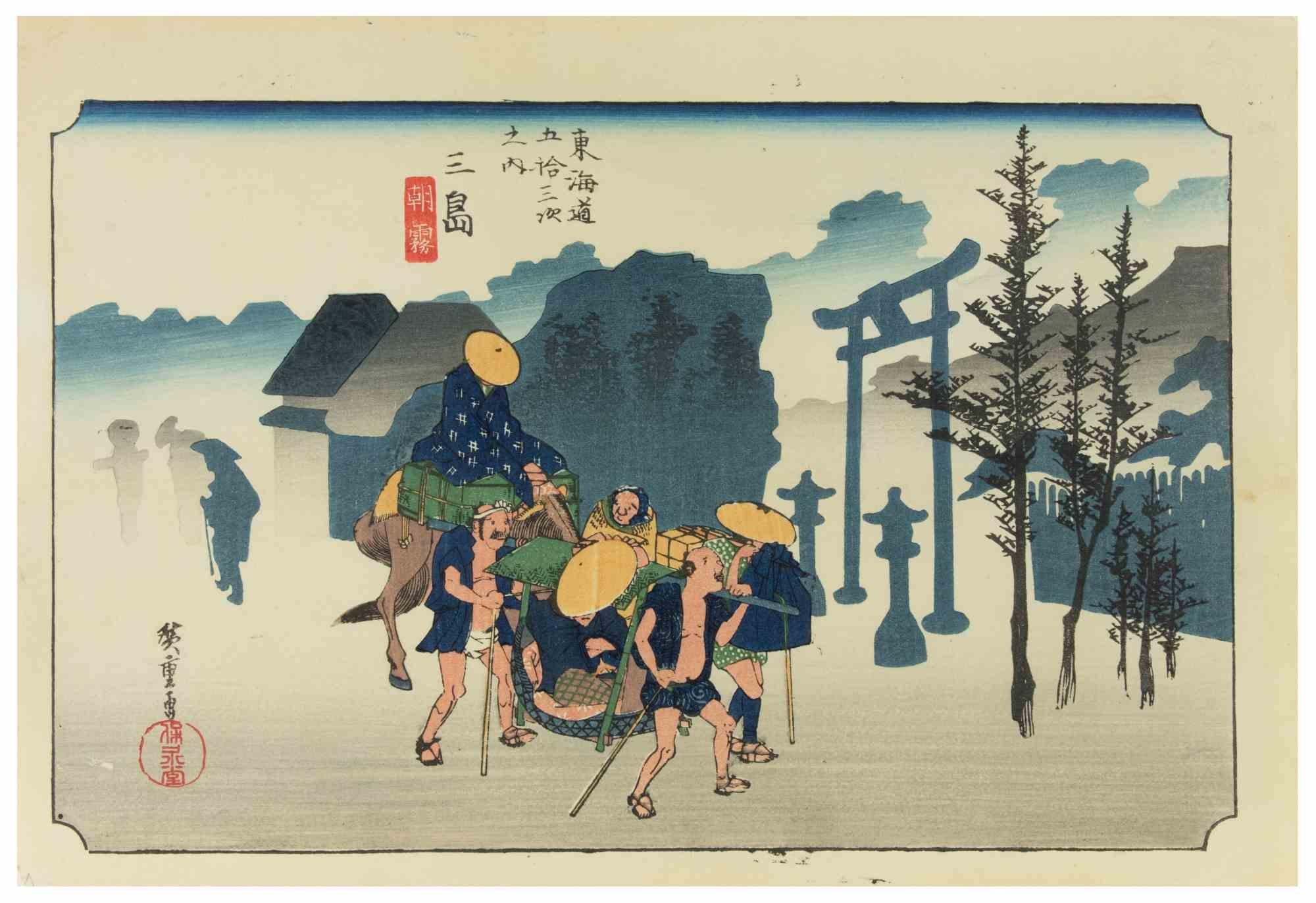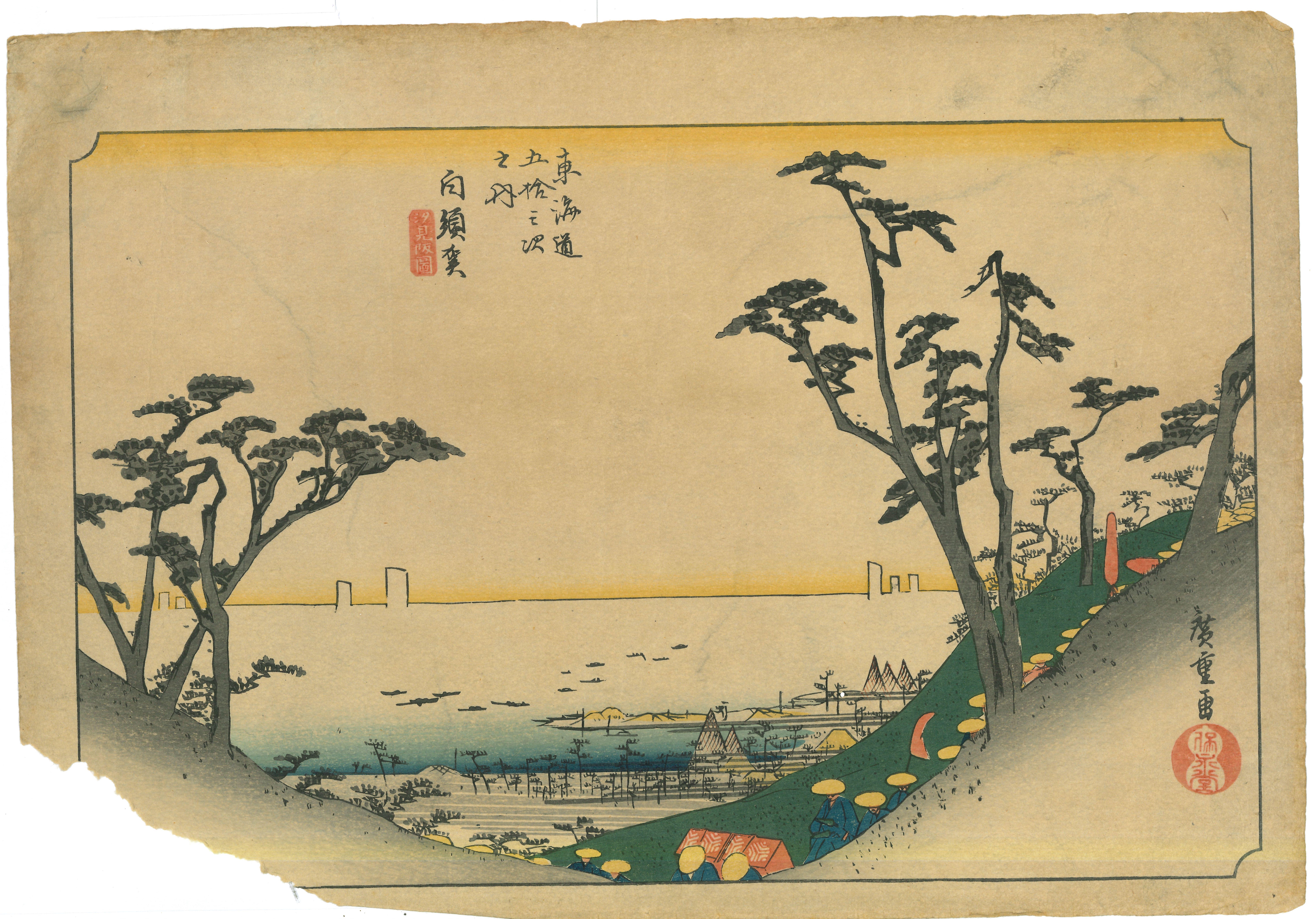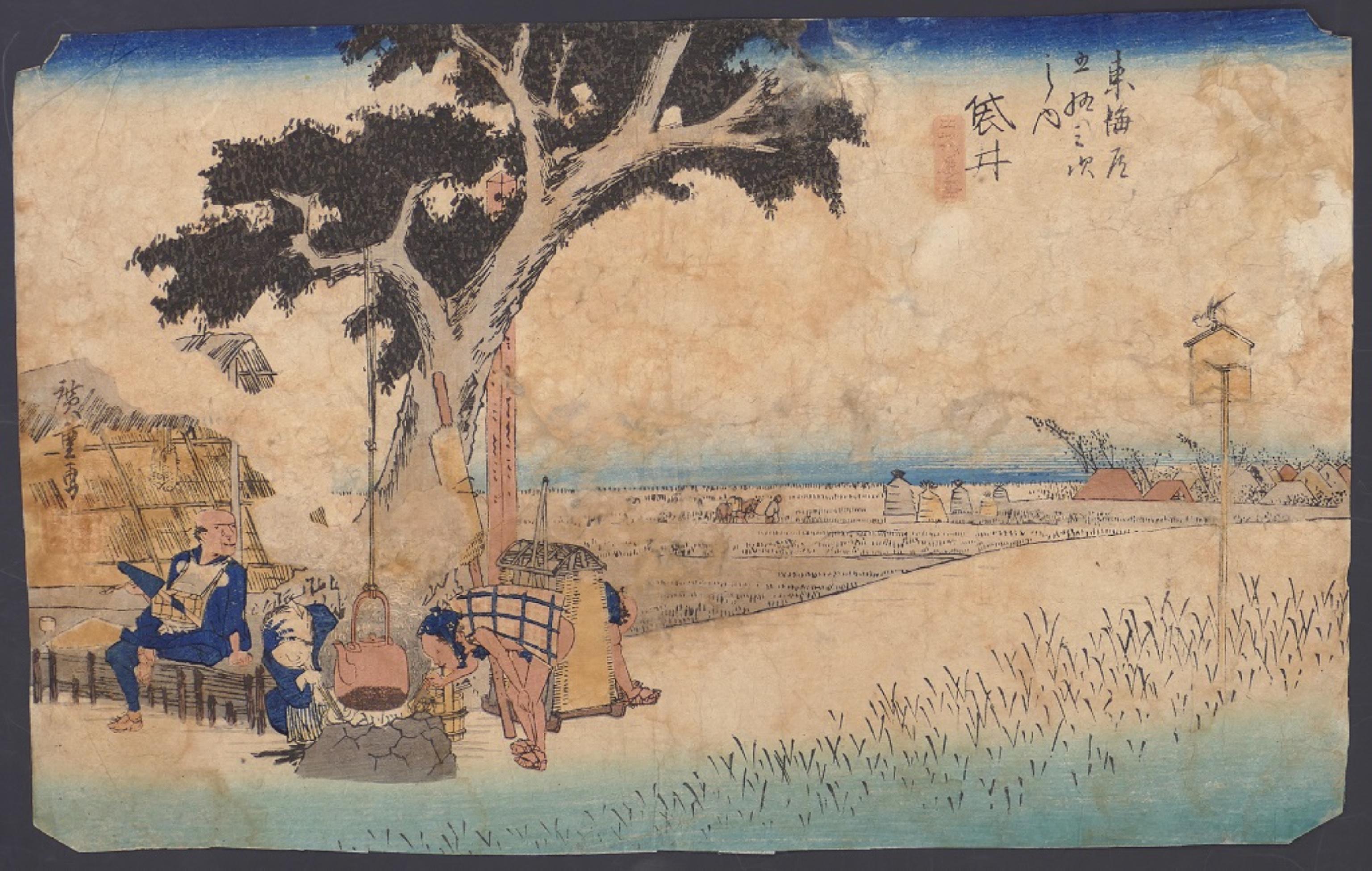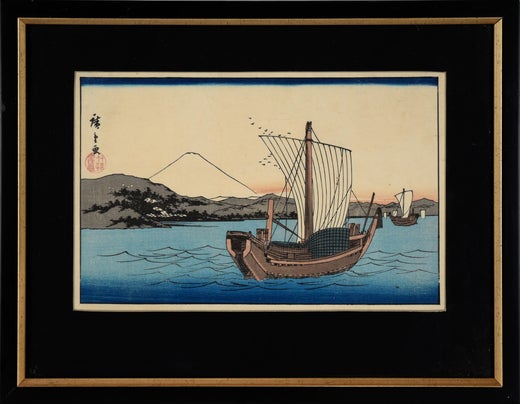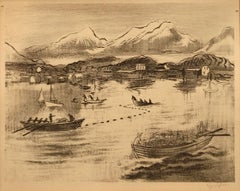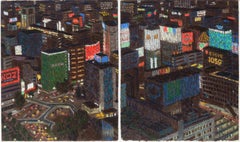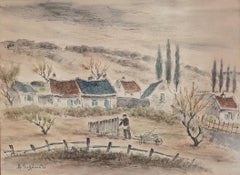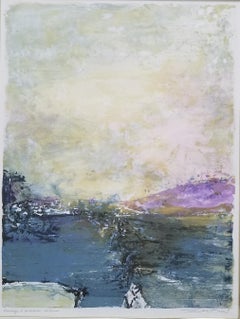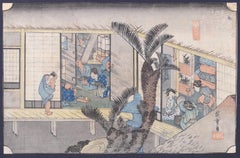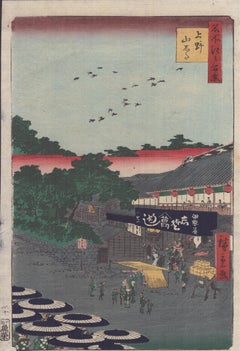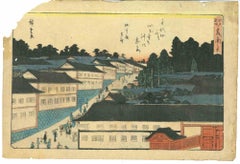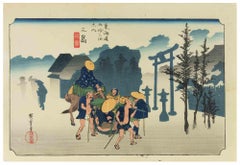Items Similar to "Dawn Inside the Yoshiwara" Utagawa Hiroshige, Japanese Landscape, Ukiyo-e
Want more images or videos?
Request additional images or videos from the seller
1 of 7
Utagawa Hiroshige"Dawn Inside the Yoshiwara" Utagawa Hiroshige, Japanese Landscape, Ukiyo-ecirca 1857
circa 1857
$1,500
£1,132.01
€1,295.98
CA$2,115.50
A$2,322.55
CHF 1,211.68
MX$28,106.12
NOK 15,186.53
SEK 14,309.71
DKK 9,674.14
About the Item
Utagawa Hiroshige
Dawn Inside the Yoshiwara, circa 1857
Woodblock print
11 x 7 inches
Utagawa Hiroshige is recognized as a master of the ukiyo-e woodblock printing tradition, having created 8,000 prints of everyday life and landscape in Edo-period Japan with a splendid, saturated ambience. Orphaned at 12, Hiroshige began painting shortly thereafter under the tutelage of Toyohiro of the Utagawa school.
His early work of narrow, vertical landscapes picturing thatched houses nestled between cliffs and vignettes of birds perched on flowering branches shows the influence of Chinese scroll painting as well as the previously dominant Kanō school of Japanese painting.
Much of Hiroshige’s work focuses on landscape. Partly inspired by Katsushika Hokusai’s popular Thirty-Six Views of Mount Fuji, Hiroshige took a softer, less formal approach with his Fifty-Three Stations of the Tokaido (1833–34), completed after traveling that coastal route linking Edo and Kyoto.
Hiroshige’s prolific output was somewhat due to his being paid very little per series. Still, this did not deter him, as he receded to Buddhist monkhood in 1856 to complete his brilliant and lasting One Hundred Famous Views of Edo (1856–58). He died in 1858, 10 years before Monet, Van Gogh, Whistler, and a host of Impressionist painters became eager collectors of Japanese art. And so Hiroshige’s surging bokashi, or varied gradient printing, lives on—visibly influencing artists like Paul Gauguin and Frank Lloyd Wright.
- Creator:Utagawa Hiroshige (1797)
- Creation Year:circa 1857
- Dimensions:Height: 19.5 in (49.53 cm)Width: 15 in (38.1 cm)
- More Editions & Sizes:Unique WorkPrice: $1,500
- Medium:
- Movement & Style:
- Period:
- Condition:
- Gallery Location:New York, NY
- Reference Number:1stDibs: LU1841216483032
Utagawa Hiroshige
Utagawa Hiroshige (1797 - 1858) was a Japanese ukiyo-e artist, considered the last great master of that tradition. Hiroshige is best known for his horizontal-format landscape series The Fifty-three Stations of the Tōkaidō and for his vertical-format landscape series One Hundred Famous Views of Edo. The subjects of his work were atypical of the ukiyo-e genre, whose typical focus was on beautiful women, popular actors, and other scenes of the urban pleasure districts of Japan's Edo period (1603–1868). The popular series Thirty-six Views of Mount Fuji by Hokusai was a strong influence on Hiroshige's choice of subject, though Hiroshige's approach was more poetic and ambient than Hokusai's bolder, more formal prints. Subtle use of color was essential in Hiroshige's prints, often printed with multiple impressions in the same area and with extensive use of bokashi (color gradation), both of which were rather labor-intensive techniques. For scholars and collectors, Hiroshige's death marked the beginning of a rapid decline in the ukiyo-e genre, especially in the face of the westernization that followed the Meiji Restoration of 1868. Hiroshige's work came to have a marked influence on Western painting towards the close of the 19th century as a part of the trend in Japonism. Western artists, such as Manet and Monet, collected and closely studied Hiroshige's compositions. Vincent van Gogh even went so far as to paint copies of two of Hiroshige's prints from One Hundred Famous Views of Edo.
About the Seller
5.0
Platinum Seller
Premium sellers with a 4.7+ rating and 24-hour response times
Established in 2022
1stDibs seller since 2022
122 sales on 1stDibs
Typical response time: <1 hour
- ShippingRetrieving quote...Shipping from: New York, NY
- Return Policy
Authenticity Guarantee
In the unlikely event there’s an issue with an item’s authenticity, contact us within 1 year for a full refund. DetailsMoney-Back Guarantee
If your item is not as described, is damaged in transit, or does not arrive, contact us within 7 days for a full refund. Details24-Hour Cancellation
You have a 24-hour grace period in which to reconsider your purchase, with no questions asked.Vetted Professional Sellers
Our world-class sellers must adhere to strict standards for service and quality, maintaining the integrity of our listings.Price-Match Guarantee
If you find that a seller listed the same item for a lower price elsewhere, we’ll match it.Trusted Global Delivery
Our best-in-class carrier network provides specialized shipping options worldwide, including custom delivery.More From This Seller
View All"Fishing Village" Joe Jones, Mid-Century, American Life, Small Town Scene
By Joe Jones
Located in New York, NY
Joe Jones
Fishing Village, 1949
Signed in pencil lower right margin
Lithograph on wove paper
Image 9 5/16 x 12 9/16 inches
Sheet 12 x 15 15/16 inches
From the edition of 250
The initial details of Jones' career are sparse, and this is intentional. The young artist was engaged in a process of self-reinvention, crafting a persona. When he submitted a work to the Sixteen Cities Exhibition at New York City's Museum of Modern Art in 1933, he briefly characterized himself: "Born St. Louis, 1909, self-taught. " Jones intentionally portrayed himself to the art community as an authentic working-class figure, backed by a compelling history. He was the youngest of five children in a family led by a one-armed house painter from St. Louis, a Welsh immigrant, and his German American spouse. At the age of ten, Jones found himself in a Missouri reformatory due to authorities' concerns over his graffiti activities. After completing elementary school, he traveled by freight car to California and back, even being arrested for vagrancy in Pueblo, Colorado. Returning to St. Louis, he attempted to settle down by working alongside his father. Yet, Jones felt a profound restlessness and was drawn toward a more elevated artistic pursuit in his late teenage years. He discovered a local collective of budding artists that formed St. Louis’s "Little Bohemia," sharing a studio and providing mutual support until he managed to secure his own modest workspace in a vacant garage.
Jones’s initial creations comprised still lifes, landscapes, and poignant portraits of those close to him. These subjects were not only accessible but also budget-friendly, as hiring models was beyond his means. He depicted himself, his father, mother, and eventually, his wife. In December 1930, at the age of 21, Jones wed Freda Sies, a modern dancer and political activist who was four years older than him.
By 1933, Jones had started gaining noteworthy local recognition through a solo exhibition at the Artists’ Guild of Saint Louis. Of the twenty-five paintings on display, one, titled River Front (private collection, previously with Hirschl and Adler Galleries), was selected to illustrate a feature article about his show in The Art Digest (February 15, 1933, p. 9). Shortly before this exhibition, a young surgeon named Dr. Robert Elman took an interest in Jones’s art, purchasing several pieces and forming a group of potential patrons committed to providing the emerging artist with a monthly stipend in exchange for art. This group was officially known as the "Co-operative Art Society," but it was informally dubbed the "Joe Jones Club. " Jones became an active participant in the St. Louis artistic scene, particularly within its bohemian segments. He embraced modernism and was a founding member of the "New Hat" movement in 1931, a playful rebellion against the conservative and traditional mainstream art establishment.
The summer of 1933 marked a significant shift in Jones’s journey. Sponsored by a dedicated ally, Mrs. Elizabeth Green, Jones, along with Freda and Green, embarked on an eastward road trip. In Washington, D. C., they explored the Corcoran Gallery of Art, the Freer Gallery (part of the Smithsonian Institution), the Library of Congress, and Mount Vernon. Following this whirlwind of art and American culture, they made their way to New York, where they visited various museums and galleries, including a stop at The New School for Social Research, which featured notable contemporary murals by fellow Missourian Thomas Hart Benton and the politically active Mexican artist, José Clemente Orozco. From June through August, Jones and Freda resided in the artist colony of Provincetown, Massachusetts, later returning home via Detroit to see Diego Rivera’s Detroit Industry mural housed at the Detroit Institute of Fine Arts.
While Elizabeth Green allegedly hoped that Jones would refine his artistic skills under the guidance of Charles Hawthorne or Richard Miller in Provincetown, Jones followed a different path. Rather than pursuing conservative mentors, he connected with an engaging network of leftist intellectuals, writers, and artists who dedicated their time to reading Marx and applying his theories to the American landscape. Jones's reaction to the traditional culture of New England was captured in his statement to a reporter from the St. Louis Post Dispatch: “Class consciousness . . . that’s what I got of my trip to New England. Those people [New Englanders] are like the Chinese—ancestor worshipers. They made me realize where I belong” (September 21, 1933). The stark social divisions he witnessed there prompted him to embrace his working-class identity even more fervently. Upon returning to St. Louis, he prominently identified himself as a Communist. This newfound political stance created friction with some of his local supporters. Many of his middle-class advocates withdrew their backing, likely influenced not only by Jones’s politics but also by his flamboyant and confrontational demeanor.
In December 1933, Jones initiated a complimentary art class for unemployed individuals in the Old Courthouse of St. Louis, the same location where the Dred Scott case was deliberated and where slave auctions formerly took place. Concurrently, the St. Louis Art League was offering paid courses. Emphasizing the theme of social activism, with a studio adorned with Soviet artwork, Jones’s institution operated for just over a year before being removed from the courthouse by local officials. The school’s political focus and unconventional teaching practices, along with its inclusion of a significant number of African American students during a period marked by rigid racial segregation, certainly contributed to its challenges. Under Jones’s guidance, the class created a large chalk pastel mural on board, measuring 16 by 37 feet, titled Social Unrest in St. Louis. Mural painting posed no challenge for the former housepainter, who was adept at handling large wall surfaces. His first significant commission in St. Louis in late 1931 was a mural that celebrated the city’s industrial and commercial fortitude for the local radio station, KMOX. This mural, aimed at conveying optimism amid severe economic hardship, showcased St. Louis's strengths in a modernist approach. When Jones resumed mural work in late 1933, his worldview had evolved considerably. The mural produced for the school in the courthouse, conceived by Jones, featured scenes of modern St. Louis selected to highlight political messages. Jones had observed the technique of utilizing self-contained scenes to craft visual narratives in the murals he encountered in the East. More locally, this compositional strategy was commonly employed by the renowned Missouri artist...
Category
1940s American Realist Landscape Prints
Materials
Paper, Lithograph
"Tokyo Diptych" Yvonne Jacquette, Japanese Urban Cityscape Nocturnal Aerial
By Yvonne Jacquette
Located in New York, NY
Yvonne Jacquette (American, b. 1935)
Tokyo Diptych, 1985
Pastel on paper
Overall 17 1/4 x 28 1/2 inches
Signed lower center
Provenance:
Carey Ellis Company, Houston, Texas
Brooke Alexander, New York
Collection of an American Corporation
Exhibited:
New York, Brooke Alexander, Yvonne Jacquette: Tokyo Nightviews, April 5 - May 3, 1986, n.p., illustrated; this exhibition later traveled to Brunswick, Maine, Bowdoin College Museum of Art, Yvonne Jacquette: Tokyo Nightviews, June 27 - August 24, 1986.
Yvonne Jacquette has a preference for high places, a circling plane, a penthouse window, an aerie from which to watch the world. Her work has often depicted the city and man-made landscape from the vantage of angels. It is a privileged perspective, long loved by photographers, who were perhaps the first to recognize the geometric grandeur of the city below. That grandeur structures Jacquette's images but is not its full content. Her work attempts to resolve the visual and emotional pardoxes of the modern metropolis. Only from the tower is there the possibility of order and context. And unlaced beauty.
Jacquette first visited Japan in 1982. Nighttime Tokyo, its cars and crowds and canyons of loud Vegas neon, made a vivid and bewildering impression on her. The neon signs, pulsing, scaling the walls of high rises, fascinated the artist, "like Times Square spread over miles." Her fascination was equal parts marvel, confusion, and curiosity—the sparks of art. She returned to Tokyo in May of 1985, choosing hotel rooms with expansive vistas. From these views Jacquette excerpted images for a series of pastel night scenes. The basic forms and colors of each drawing were blocked in during night sessions by the window. She worked in the dark, selecting colors by flashlight. In daylight, she sharpened the geometry and corrected ambiguous passages. She refined the drawings further in the studio until the images read clearly. Photographic correctness was not important. The finished drawings are complete statements, not simply preparatory sketches for paintings. They have the authority of expert witness. In clear, discreet jots of pastel they record the performance of seeing, each touch of color attesting to a moment's close scrutiny.
Yvonne Jacquette was born on December 15, 1934 in Pittsburgh, Pennsylvania and grew up in Stamford, Connecticut. She attended the Rhode Island School of Design, Providence from 1952 to 1955, when she moved to New York City. Her late husband was photographer Rudy Burckhardt, and the couple were part of a circle of artist friends that included Fairfield Porter, Alex Katz, Red Grooms, and Mimi Gross. She continues to live and work in New York City, as well as in Searsmont, Maine.
A flight to San Diego in 1969 sparked Jacquette’s interest in aerial views, after which she began flying in commercial airliners to study cloud formations and weather patterns. She soon started sketching and painting the landscape as seen from above, beginning a process that has developed into a defining element of her art. Her first nocturnal painting...
Category
1980s American Modern Landscape Drawings and Watercolors
Materials
Paper, Pastel
"Suburb of Gif-sur-Yvette, France" Henry Yuzuru Sugimoto, Modernist Landscape
Located in New York, NY
Henry Yuzuru Sugimoto
Suburb of Gif-sur-Yvette, France, circa 1928-32
Signed lower left
Watercolor on paper
11 x 14 inches
Henry Sugimoto was born in Wakayama, Japan, on March 12, 1900. His father left for the United States shortly after he was born, and his mother joined him some years later, with the result that the young Henry was raised largely by his grandparents. Following the end of World War I, Henry Sugimoto arrived in the United States as a "yobiyose" (child brought over) and settled with his parents in Hanford, California. After attending Hanford High School, he enrolled at the University of California, Berkeley. He soon grew absorbed in art and his parents agreed to let him enroll at the California School of Arts and Crafts. After studying there for four years with a concentration in oil painting, he graduated with honors in 1928. He then moved to the California School for Fine Arts, but after a year there he decided to travel to France, the international artistic capital, for further study. Once arrived in Paris, Sugimoto became close to the circle of Japanese...
Category
1930s Modern Figurative Drawings and Watercolors
Materials
Paper, Watercolor
"Hommage a Nobutaka Shikanai, " Zao Wou-Ki, Abstract Lithograph Mid-century Print
By Zao Wou-Ki
Located in New York, NY
Zao Wou-Ki (1920 - 2013)
Hommage a Nobutaka Shikanai - 1991, (Agerup 354)
Color lithograph on BFK Rives watermarked paper, full margins
24 x 18 1/4 inches
Signed and titled in the sheet
Published by Fuji Television Gallery, Tokyo
Zao (Zhao) Wou Ki combines Oriental landscape abstraction with French influence. He was born in Beijing on February 13, 1921, and from the age of ten, Zao drew and painted with great freedom. He learned from his grandfather that calligraphy is an art when it transmits an emotion to the person looking at it. At age fourteen he enrolled at the School of Fine Arts in Hangzhou, where he remained for six years. He studied and then taught at the Hongchow National Academy of Fine Arts. In 1942, he organized an exhibition of works by his teacher, Wu Dayu, along with some of his own.
In 1948, he moved to Paris where he has lived and worked ever since, although he has exhibited in New York City. He attended the Académie de la Grande Chaumière and lived at Rue du Moulin Vert nearby Alberto Giacometti's studio. Making the acquaintance of Hans Hartung, Nicolas de Staël, Pierre Soulages, Viera da Silva...
Category
1990s Abstract Abstract Prints
Materials
Paper, Lithograph
"Hydrangeas, " Walter Inglis Anderson, Mississippi Southern Illustrator, Flowers
Located in New York, NY
Walter Anderson ( American, 1903 - 1965)
Hydrangeas, circa 1950
Mixed media on paper
11 x 8 1/2 inches
Provenance:
Luise Ross Gallery, New York
Private Collection, New Jersey
Acquired from the estate of the above, 2021
Walter Anderson firmly believed that quality art was an important part of life and should be made available to everyone. As he said, "There should be simple, good decorations, to be sold at prices to rival the five-and-ten." Noticing that only poor quality art was available in stores and little was available for children, he resolved to make art which could be reproduced easily and sell inexpensively — linoleum block prints. This technique enabled him to provide affordable, quality art.
The technique of linoleum block printing is a simple concept; however, it requires much skill and talent to actually produce memorable art. Anderson purchased surplus "battleship linoleum," thicker than ordinary linoleum with a burlap backing for better support, to create his blocks. During the mid-1940s, he created almost 300 linocuts working in the attic of the sea-side plantation house, Oldfields, his wife's family home in Gautier. Masses of linoleum chips accumulated at the foot of the attic stairs as he often worked night and day. He began with sketching out a design directly on the linoleum. Once he had carved the image into the surface, he used the back of faded, surplus stock wallpaper that a friend sent him, laying long strips on top of the inked linoleum. A roller made of sewer pipe filled with sand served as his press. When the print was completed, he often colored it by hand with bold strokes and vivid colors. The prints were sold at Shearwater Pottery, the family business, for a mere dollar a foot.
But "what about a well-designed fairy tale for a child's room?" he asked himself. Since there was a lack of affordable art for children, much of his work with linoleum blocks focused on subjects for children. He depicted fables and fairy tales ranging from Arabian Nights, to Germany and the Grimm Brothers' Rapunzel, to the French story of The White Cat, to the Greek tales such as Europa and the Bull, and to tales from China, India, and other cultures. Anderson also created "mini" books featuring the alphabet and Robinson Cat. The blocks are not only alive with the story being depicted, but they are also filled with designs taken from Best-Maugard's Method for Creative Design. Swirls, half-circles and zig-zag lines fill every available space on the linoleum block making them come alive and capture their audience.
But fairy tales, children's verses and the "mini" books, consisting of about 90 blocks, were not the sole subject of Anderson's linoleum block prints. In total, he created approximately 300 linoleum blocks with subjects ranging from coastal flora and fauna, coastal animals, and sports and other coastal activities. Anderson even created linoleum blocks to be used to print tablecloths and clothing, some worn by his own children. Color and subjects of the linoleum block prints were not the only things that got them noticed.
In 1945 when Anderson was creating these prints, the standard size of linoleum block prints was only 12 by 18 inches. These small dimensions were due to the common size of the paper available and the restrictions made by national competitions. Since Anderson used wallpaper...
Category
Mid-20th Century American Modern Landscape Paintings
Materials
Paper, Crayon
"Nasturtiums" Chiura Obata, Japanese American, Red and Blue Delicate Flowers
By Chiura Obata
Located in New York, NY
Chiura Obata
Nasturtiums, circa 1940
Signed and stamped lower left
Watercolor on paper
15 x 9 5/8 inches
Born in the Okayama prefecture of Japan, Chiura Obata was adopted by his uncle, an artist. As a child he was trained in ink painting, and at 14 he was apprenticed to the painter Murata Tanryo in Tokyo. He also studied with Kogyo Terasaki and Goho Hasimoto.
In 1903, Obata moved to San Francisco and began working as an illustrator for The New World and The Japanese American, two of the city's Japanese newspapers. He also did work as a commercial designer. Obata helped establish the East West Art Society in San Francisco in 1921, which sought to promote cross-cultural understanding through art. This goal was reflected in his embrace of the Nihonga style, which fused traditional Japanese sumi-e ink painting with the conventions of western naturalism.
He spent much of the 1920s painting landscapes throughout California, and among his favorite subjects were mountain landscapes. In 1927, he visited Yosemite and the Sierra Nevada, creating over a hundred paintings and sketches of the high country. Obata stayed in the USA until the death of his father in 1928.
Between 1928 and 1932, he worked in Tokyo as a painter and transformed his California landscape watercolors...
Category
1940s Modern Still-life Drawings and Watercolors
Materials
Paper, Watercolor
You May Also Like
Akasaka - Woodcut by Utagawa Hiroshige - 1831
By Utagawa Hiroshige
Located in Roma, IT
Akasaka is a polychrome woodblock print, the plate n. 36 from the series - Fifty-three Stations of the Tôkaidô (Ryosha Shofu npo Zu), designed by Utagawa Hiroshige (歌川 広重, 1797-1858)...
Category
Mid-19th Century Figurative Prints
Materials
Paper, Woodcut
Hiroshige (1797-1858) - Ueno Yamashita
By Utagawa Hiroshige (Ando Hiroshige)
Located in BRUCE, ACT
Artist: Utagawa Hiroshige (Hiroshige Ando 1797-1858)
Title: No.12 Ueno Yamashita
Series: One Hundred Famous Views of Edo (名所江戸百景)
Size: O-ban 大判
Age: 1858
Category
1850s Landscape Prints
Materials
Woodcut
$3,710 Sale Price
30% Off
Kasumigaseki Nokei - Woodcut by Utagawa Hiroshige - 1840
By Utagawa Hiroshige
Located in Roma, IT
Kasumigaseki Nokei is a polychrome woodblock print (nishiki-e, ink and colour on paper) by Utagawa Hiroshige (Japanese, 1797-1858). This plate is from the print suite Famous Places o...
Category
1840s Modern Figurative Prints
Materials
Woodcut
Asagiri - Woodcut by Utagawa Hiroshige - 1832
By Utagawa Hiroshige
Located in Roma, IT
Asagiri is a woodcut print realized by Utagawa Hiroshige in 1832.
It is part of the suite "The Fifty-three Stations of Tokaido".
Very good condition.
Category
1830s Modern Figurative Prints
Materials
Woodcut
Shirasuga, Shiomi -zaka zu - Original Woodcut by Utagawa Hiroshige - 1833/1834
By Utagawa Hiroshige
Located in Roma, IT
Shirasuga, Shiomi -zaka zu (View of Shima Slope) is a superb polychrome woodblock print (nishiki-e, ink and colour on paper) by Utagawa Hiroshige (Japanese, 1797-1858). This is the p...
Category
1830s Modern Figurative Prints
Materials
Woodcut
Fukuroi Dejaya No Zu - Orignal Woodcut by Utagawa Hiroshige - 1833
By Utagawa Hiroshige
Located in Roma, IT
Fukuroi Dejaya No Zu (An Outdoor Tea Stall at Fukuroi), is a beautiful color woodblock print on paper, the plate n. 28 from the series Fifty-three Stations Along the Tokaido (Tokai...
Category
Mid-19th Century Landscape Prints
Materials
Paper, Woodcut
